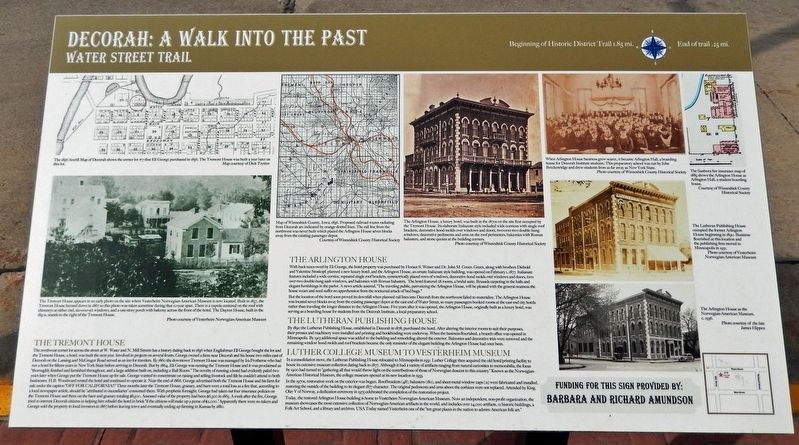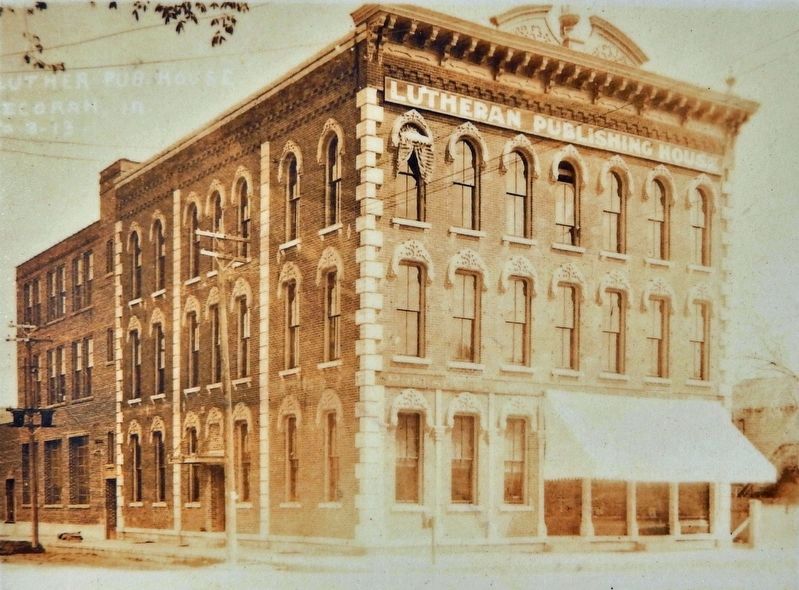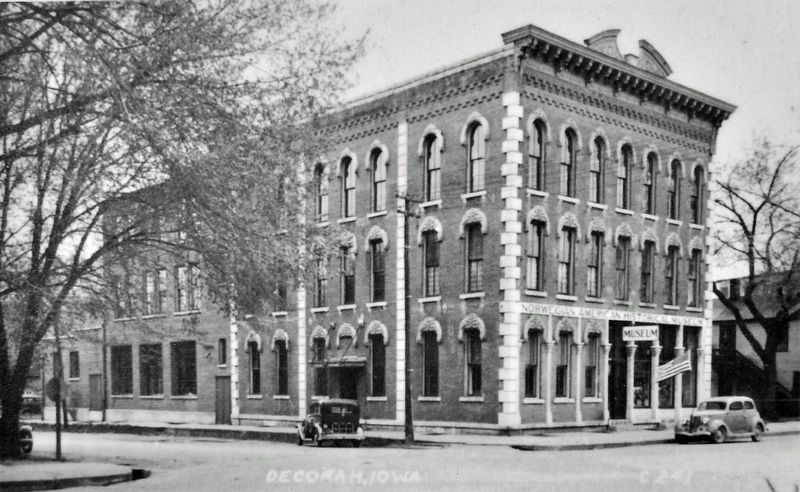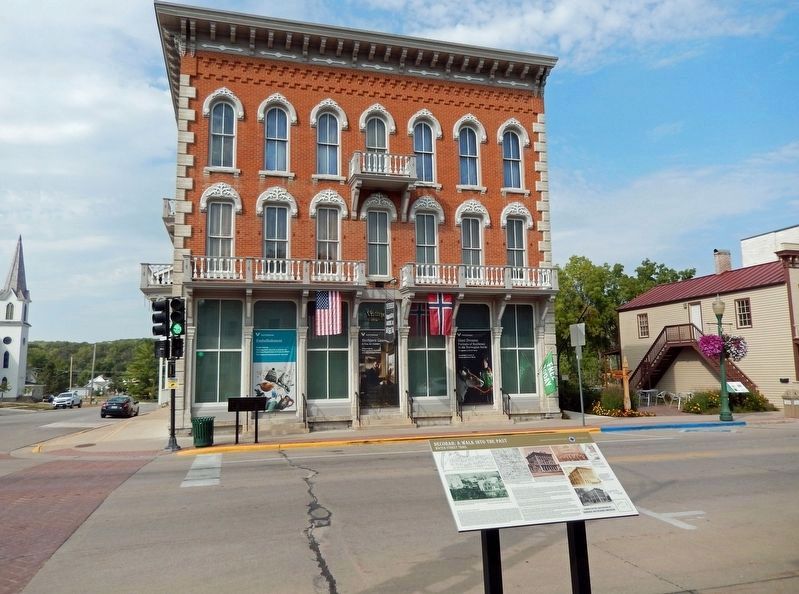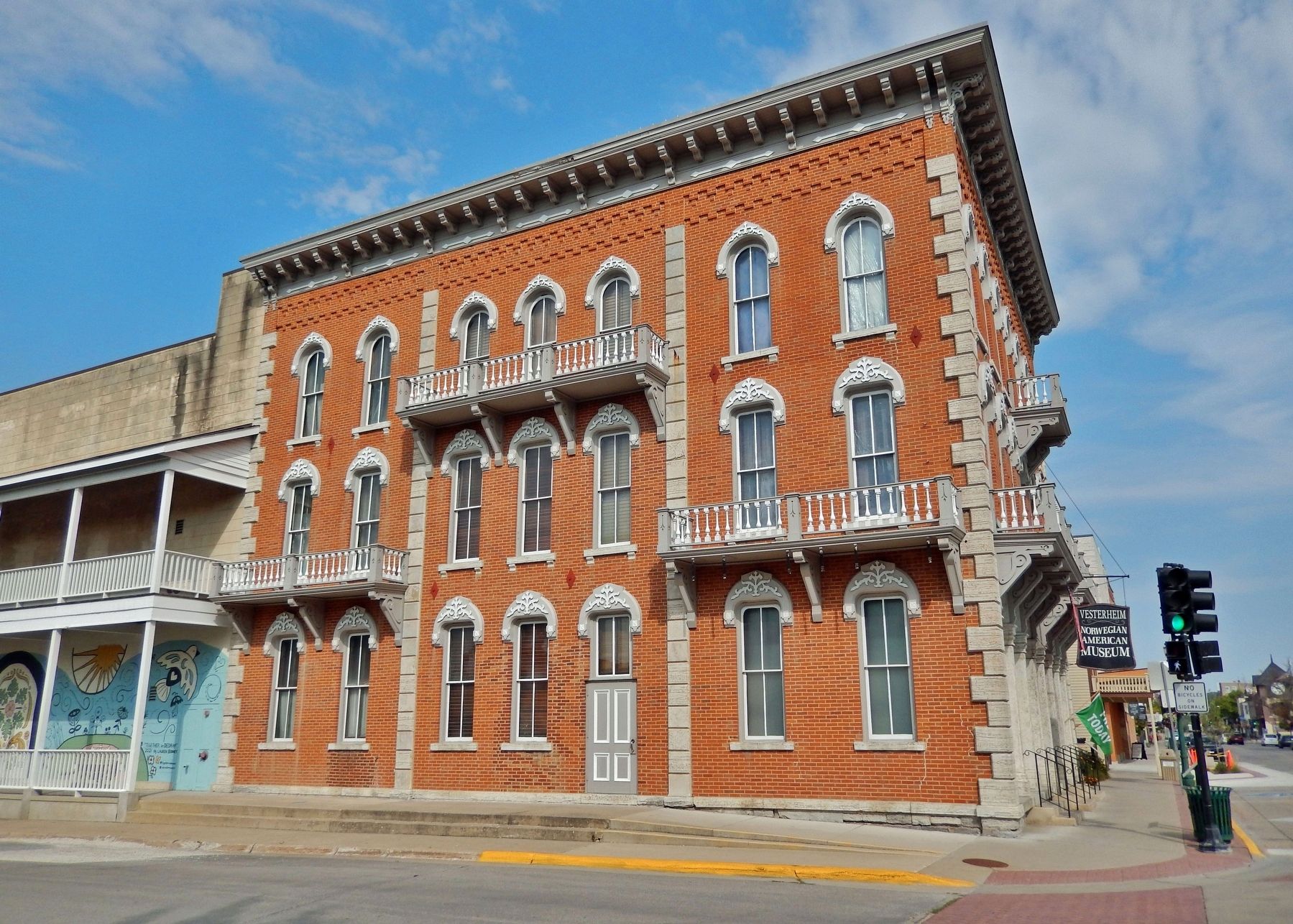Decorah in Winneshiek County, Iowa — The American Midwest (Upper Plains)
Decorah: A Walk into the Past
Water Street Trail
The Tremont House
The northwest corner lot across the street at W. Water and N. Mill Streets has a history dating back to 1856 when Englishman Eli George bought the lot and the Tremont House, a hotel, was built the next year. Involved in projects on several fronts, George owned a farm near Decorah and his house two miles east of Decorah on the Lansing and McGregor Road served as an inn for travelers. By 1860 the downtown Tremont House was managed by Ira Protheroe who had run a hotel for fifteen years in New York State before arriving in Decorah. But by 1864, Eli George was running the Tremont House and it was proclaimed as "thoroughly finished and furnished throughout, and a large addition built on, including a Ball Room." The novelty of running a hotel had evidently paled two years later when George put the Tremont House up for sale. George wanted to concentrate on raising and selling livestock and felt he couldn't attend to both businesses. H.B. Woodward rented the hotel and continued to operate it. Near the end of 1866, George advertised both the Tremont House and his farm for sale under the caption "OFF FOR CALIFORNIA!!" Three months later the Tremont House, granary, and barn were a total loss as a fire that, according to a local newspaper article, should be "attributed to incendiaries" consumed them. With prophetic foresight, George had taken out four insurance policies on the Tremont House and three on the barn and granary totaling $8,500. Assessed value of the property had been $6,300 in 1865. A week after the fire, George tried to interest Decorah citizens in helping him rebuild the hotel in brick "if the citizens will make up a purse of $2,000." Apparently there were no takers and George sold the property to local investors in 1867 before leaving town and eventually ending up farming in Kansas by 1880.
The Arlington House
With back taxes owed by Eli George, the hotel property was purchased by Horace S. Weiser and Dr. John M. Green. Green, along with brothers Diebold and Valentine Stoskopf, planned a new luxury hotel, and the Arlington House, an ornate Italianate style building, was opened on February 1, 1877. Italianate features included a wide cornice, repeated single roof brackets, symmetrically placed rows of windows, decorative hood molds over windows and doors, two-over-two double-hung sash windows, and balconies with Roman balusters. The hotel featured 28 rooms, a bridal suite, Brussels carpeting in the halls and elegant furnishings in the parlor. A news article assured, “The traveling public, patronizing the Arlington House, will be pleased with the general neatness the house wears and need suffer no apprehension from the nocturnal attack
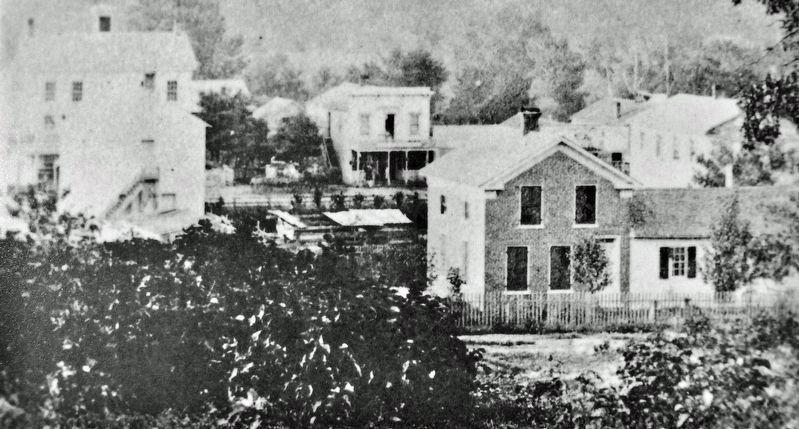
Courtesy Vesterheim Norwegian-American Museum
2. Marker detail: The Tremont House
The Tremont House appears in an early photo on the site where Vesterheim Norwegian-American Museum is now located. Built in 1857, the Tremont House burned down in 1867 so this photo was taken sometime during that 10-year span. There is a cupola centered on the roof with chimneys at either end, six-over-six windows, and a one-story porch with balcony across the front of the hotel. The Dayton House, built in the 1850s, stands to the right of the Tremont House.
But the location of the hotel soon proved its downfall when planned rail lines into Decorah from the northwest failed to materialize. The Arlington House was located seven blocks away from the existing passenger depot at the east end of Water Street, so many passengers booked rooms at the east end city hotels rather than traveling the longer distance to the Arlington House. Five years after it was opened, the Arlington House, originally built as a luxury hotel, was serving as a boarding house for students from the Decorah Institute, a local preparatory school.
The Lutheran Publishing House
By 1890 the Lutheran Publishing House, established in Decorah in 1878, purchased the hotel. After altering the interior rooms to suit their purposes, their presses and machinery were installed and printing and bookbinding were underway. When the business flourished, a branch office was opened in Minneapolis. By 1913 additional space was added to the building and remodeling altered the exterior. Balconies and decorative trim were removed and the remaining window hood molds and roof brackets became the only reminder of the elegant building the Arlington House had once been.
Luther College Museum to Vesterheim Museum
In a consolidation move, the Lutheran Publishing House relocated to Minneapolis in 1931. Luther College
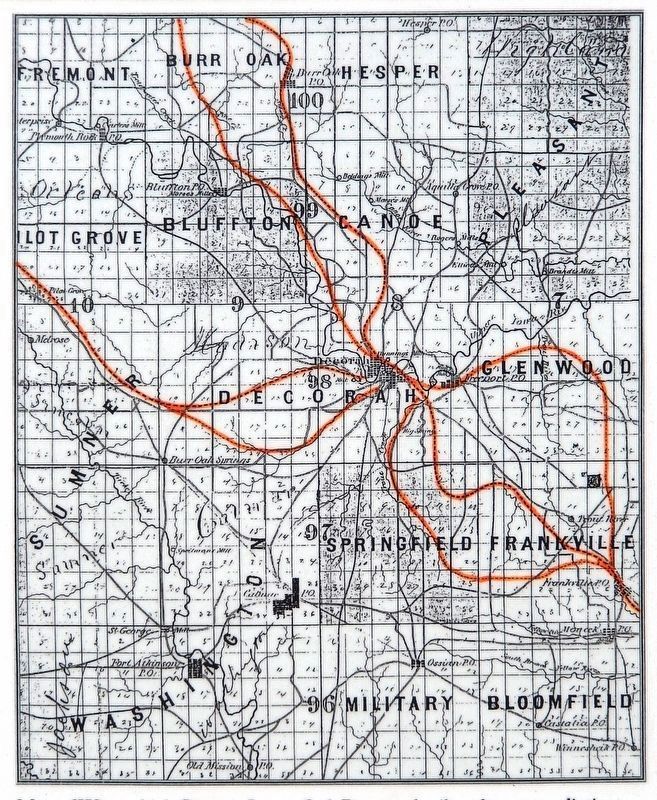
Courtesy Winneshiek County Historical Society
3. Marker detail: Map of Winneshiek County, Iowa, 1856
Proposed railroad routes radiating from Decorah are indicated by orange dotted lines. The rail line from the northwest was never built which placed the Arlington House seven blocks away from the existing passenger depot.
Today, the restored Arlington House building is home to Vesterheim Norwegian-American Museum. Now an independent, non-profit Organization, the museum showcases the most extensive collection of Norwegian-American artifacts in the world, and includes over 24,000 artifacts, 12 historic buildings, a Folk Art School, and a library and archives. USA Today named Vesterheim one of the "ten great places in the nation to admire American folk art."
[other photo captions]
• The 1856 Averill Map of Decorah shows the corner
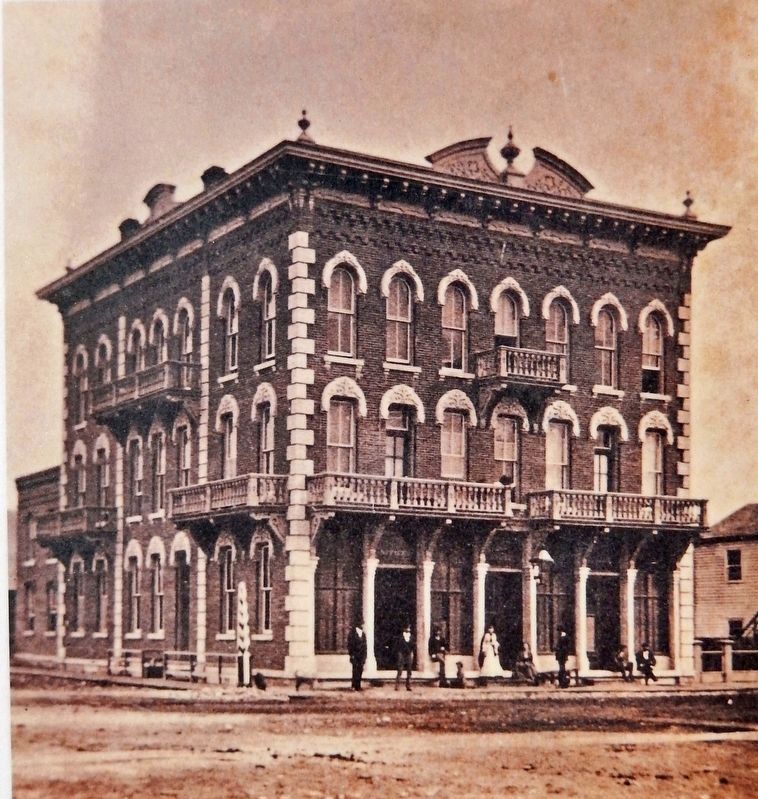
Courtesy Winneshiek County Historical Society
4. Marker detail: The Arlington House
The Arlington House, a luxury hotel, was built in the 1870s on the site first occupied by the Tremont House. Its elaborate Italianate style included wide cornices with single roof brackets, decorative hood molds over windows and doors, two-over-two double hung windows, decorative pediments and urns on the roof perimeters, balconies with Roman balusters, and stone quoins at the building corners.
• The Sanborn fire insurance map of 1885 shows the Arlington House as Arlington Hall, a student boarding house.
Funding for this sign provided by: Barbara and Richard Amundson
Topics. This historical marker is listed in these topic lists: Architecture • Arts, Letters, Music • Education • Industry & Commerce. A significant historical year for this entry is 1856.
Location. 43° 18.246′ N, 91° 47.52′ W. Marker is in Decorah, Iowa, in Winneshiek County. Marker is on West Water Street just east of Mill Street, on the right when traveling east. The marker is located along the sidewalk, near the southeast corner of the intersection. Touch for map. Marker is at or near this postal address: 523 West Water Street, Decorah IA 52101, United States of America. Touch for directions.
Other nearby markers. At least 8 other markers are within walking distance of this marker. A different marker also named Decorah: A Walk into the Past (a few steps from this marker); Welcome to Vesterheim (within shouting distance of this marker); Vesterheim (within shouting distance of this marker); Norsvin Mill (within shouting distance of this marker); Egge-Koren House (within shouting distance of this marker); Valders House (about 300 feet away,
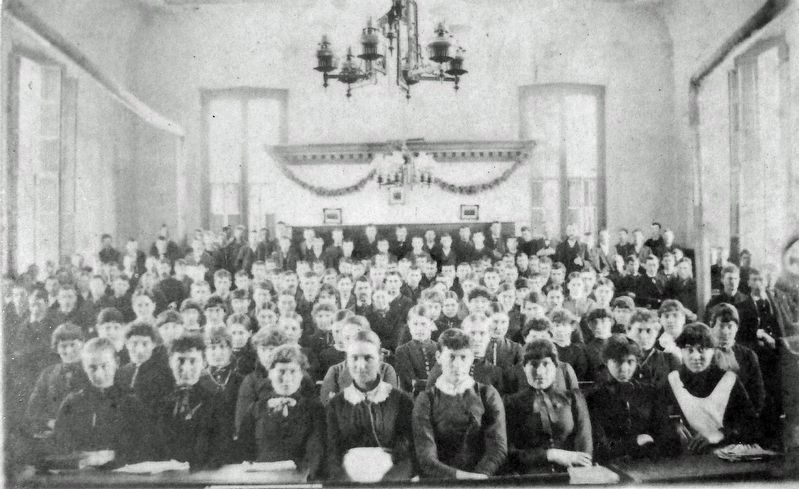
Courtesy Winneshiek County Historical Society
5. Marker detail: Arlington Hall
When Arlington House business grew scarce, it became Arlington Hall, a boarding house for Decorah Institute students. This preparatory school was run by John Breckenridge and drew students from as far away as New York State.
Also see . . .
1. Vesterheim Norwegian-American Museum (Wikipedia). Excerpt:
Vesterheim Museum was founded in 1877 as the Norwegian-American Historic Museum. It began as a part of nearby Luther College. In 1965, the Norwegian-American Museum became an independent non-profit museum with its own staff and board of directors. The museum's main building is the historic Arlington Hotel/Publishing House. Luther College purchased the abandoned building in 1932 and moved the museum collection to that site in 1933. Luther sold the building to Vesterheim for $1.00 in 1969.(Submitted on January 30, 2024, by Cosmos Mariner of Cape Canaveral, Florida.)
2. What is Vesterheim?. Excerpt:
Exhibits at Vesterheim, the National Norwegian-American Museum and Folk Art School, explore the diversity of American immigration through the lens of the Norwegian-American experience and showcase the best in historic and contemporary Norwegian folk arts. This national treasure features a world-class collection of 33,000 artifacts and a Heritage Park of 12 historic buildings, as well as a Folk Art School in scenic Decorah, Iowa.(Submitted on January 30, 2024, by Cosmos Mariner of Cape Canaveral, Florida.)
Credits. This page was last revised on January 30, 2024. It was originally submitted on January 28, 2024, by Cosmos Mariner of Cape Canaveral, Florida. This page has been viewed 58 times since then. Photos: 1, 2, 3, 4, 5, 6. submitted on January 29, 2024, by Cosmos Mariner of Cape Canaveral, Florida. 7, 8, 9. submitted on January 30, 2024, by Cosmos Mariner of Cape Canaveral, Florida.
